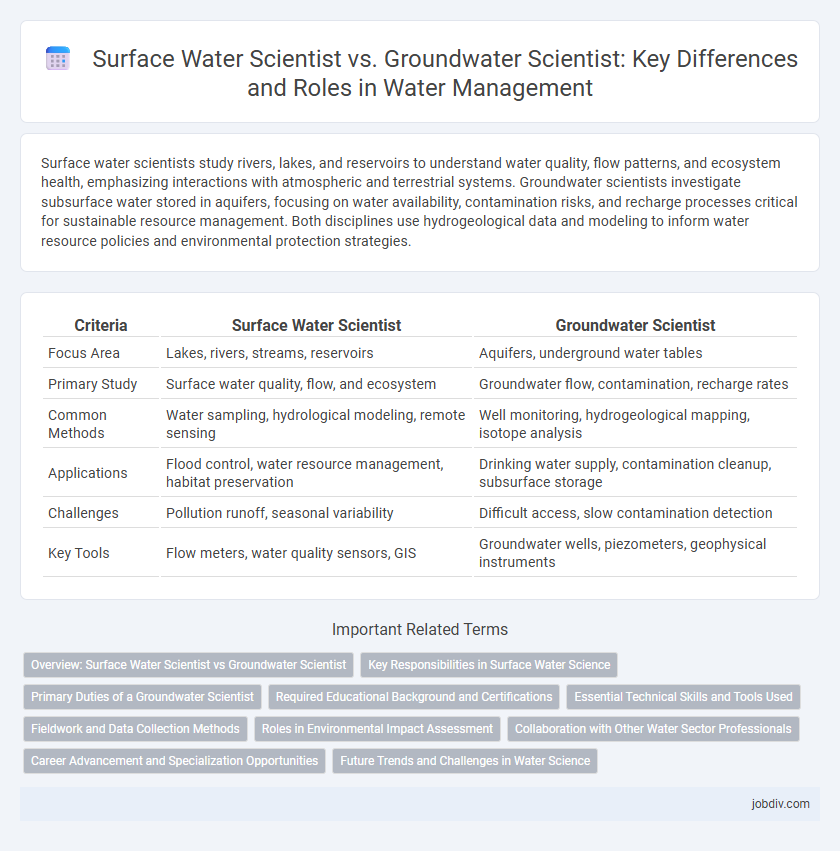Surface water scientists study rivers, lakes, and reservoirs to understand water quality, flow patterns, and ecosystem health, emphasizing interactions with atmospheric and terrestrial systems. Groundwater scientists investigate subsurface water stored in aquifers, focusing on water availability, contamination risks, and recharge processes critical for sustainable resource management. Both disciplines use hydrogeological data and modeling to inform water resource policies and environmental protection strategies.
Table of Comparison
| Criteria | Surface Water Scientist | Groundwater Scientist |
|---|---|---|
| Focus Area | Lakes, rivers, streams, reservoirs | Aquifers, underground water tables |
| Primary Study | Surface water quality, flow, and ecosystem | Groundwater flow, contamination, recharge rates |
| Common Methods | Water sampling, hydrological modeling, remote sensing | Well monitoring, hydrogeological mapping, isotope analysis |
| Applications | Flood control, water resource management, habitat preservation | Drinking water supply, contamination cleanup, subsurface storage |
| Challenges | Pollution runoff, seasonal variability | Difficult access, slow contamination detection |
| Key Tools | Flow meters, water quality sensors, GIS | Groundwater wells, piezometers, geophysical instruments |
Overview: Surface Water Scientist vs Groundwater Scientist
Surface water scientists specialize in analyzing rivers, lakes, and reservoirs, focusing on hydrology, water quality, and ecosystem health to manage surface water resources sustainably. Groundwater scientists study aquifers and subsurface water flow, emphasizing groundwater contamination, recharge rates, and sustainable extraction methods. Both roles require expertise in hydrological modeling, water chemistry, and environmental regulations but differ in their primary study environments and methods.
Key Responsibilities in Surface Water Science
Surface water scientists primarily monitor and analyze rivers, lakes, and streams to assess water quality, flow rates, and ecological health. They collect and interpret hydrological data to manage water resources, predict flood events, and support environmental conservation efforts. Their work often involves collaboration with environmental agencies to develop sustainable water management strategies that protect aquatic ecosystems.
Primary Duties of a Groundwater Scientist
Groundwater scientists primarily focus on studying aquifers, analyzing groundwater flow, and assessing water quality to ensure sustainable water resource management. They collect and interpret data from wells, monitor contamination levels, and develop models to predict groundwater behavior under various environmental conditions. Their work supports water supply planning, pollution remediation, and ecosystem preservation by providing critical insights into subsurface water dynamics.
Required Educational Background and Certifications
Surface Water Scientists typically require a Bachelor's or Master's degree in Environmental Science, Hydrology, or Civil Engineering, emphasizing courses in freshwater ecosystems and watershed management. Groundwater Scientists often pursue degrees in Hydrogeology, Geology, or Environmental Engineering, with specialized training in aquifer dynamics and subsurface hydrology essential for professional practice. Certifications such as Professional Geologist (PG) or Certified Hydrogeologist (CHG) enhance credentials for Groundwater Scientists, while Surface Water Scientists benefit from certifications like Certified Ecologist (CE) or Water Quality Association (WQA) credentials.
Essential Technical Skills and Tools Used
Surface water scientists utilize hydrological modeling software such as HEC-RAS and GIS tools to analyze river flow, sediment transport, and watershed data. Groundwater scientists employ specialized tools like groundwater flow models (MODFLOW), geophysical instruments, and water quality analyzers to assess aquifer properties and contamination levels. Both roles require proficiency in data collection techniques, remote sensing technology, and statistical analysis for accurate environmental assessments.
Fieldwork and Data Collection Methods
Surface water scientists primarily collect data through direct observations and measurements of rivers, lakes, and streams, using tools like flow meters, water quality sensors, and remote sensing technologies. Groundwater scientists focus on subsurface sampling techniques such as drilling wells, installing piezometers, and conducting aquifer pump tests to analyze water quality and hydraulic properties. Both disciplines emphasize precise fieldwork protocols but differ in their approaches due to the distinct environments of surface versus subsurface water systems.
Roles in Environmental Impact Assessment
Surface water scientists analyze lakes, rivers, and streams to assess pollution levels, flow changes, and ecosystem health, providing crucial data for Environmental Impact Assessments (EIAs). Groundwater scientists evaluate subterranean water quality, aquifer recharge rates, and contamination risks, contributing essential insights for EIAs related to water resource management and land development projects. Both roles collaborate to ensure comprehensive assessment of hydrological impacts on the environment.
Collaboration with Other Water Sector Professionals
Surface water scientists and groundwater scientists collaborate closely with hydrologists, environmental engineers, and water resource managers to develop comprehensive water management strategies. They integrate surface and subsurface data to assess water quality, availability, and ecosystem impacts, ensuring sustainable use of water resources. Effective collaboration enhances predictive modeling, policy development, and the design of remediation projects addressing both surface and groundwater challenges.
Career Advancement and Specialization Opportunities
Surface water scientists often advance through roles involving hydrology, ecology, and watershed management, specializing in river, lake, and reservoir studies, while groundwater scientists focus on hydrogeology, aquifer assessment, and contamination remediation. Career advancement in surface water science may lead to positions in environmental consulting, regulatory agencies, or water resource management, whereas groundwater scientists frequently move into roles in environmental engineering, geotechnical consulting, and groundwater modeling. Both fields offer specialization opportunities, with surface water scientists exploring sediment transport and habitat restoration, and groundwater scientists specializing in well drilling technologies and subsurface contaminant transport.
Future Trends and Challenges in Water Science
Surface water scientists increasingly utilize remote sensing and hydrological modeling to predict flood risks and manage reservoirs amid climate change-induced variability. Groundwater scientists face challenges in addressing contamination and sustainable aquifer replenishment, leveraging advances in geochemical tracing and machine learning for groundwater quality assessment. Both disciplines converge on integrated water management approaches, emphasizing data-driven decision-making to enhance resilience against water scarcity and extreme weather events.
Surface Water Scientist vs Groundwater Scientist Infographic

 jobdiv.com
jobdiv.com